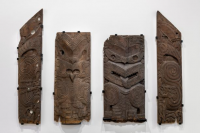
A rehanging of the bread and butter display of the permanent collection is always going to be an event. It’s fascinating to see how the old (and new) favourites will be reinterpreted for the Zeitgeist, what gets retired and what’s brought out again. Te Wheke Pathways Across Oceania is unusual for such a hang in that it has opted for a distinct overall theme of culture(s) defined and connected by the Pacific – perhaps inspired by Epeli Hau’ofa’s idea of islands connected rather than separated by ocean. “Te wheke” means “octopus”, an intelligent and resilient creature that is familiar to all Pacific cultures, symbolic of voyaging. At its heart this is an exhibition that seeks to bypass a Eurocentric model of art history entirely. Rather strikingly for a New Zealand gallery, if you take the most direct route from the stairs and elevators, you enter the exhibition through a room of work by contemporary Pasifika artists – Grace Ngaputa Pera, Edith Amituanai, Sione Monu, Yuki Kihara, John Pule, Fatu Feu’u, Michel Tuffery, and a tapa collaboration between Robin White and Ruha Fifita – as well as historical artefacts by unknown creators, before you pass into the rest of the hang. It’s an unexpected initiation, but a logical one. The experience is loosely thematic but not in a constraining way, flowing from Māori whakairo made for Pākehā markets and Goldie and Lindauer portraits, Europeans in the Pacific and Pākehā modernists to Māori artists working within an international modern or contemporary aesthetic. Unlike more traditional hangs it is a bit difficult to just float around browsing as there is a distinctly didactic, mediated feeling to the layout. Connections tend to be made for you rather than allowing you to make them for yourself. There is also the question of why some artists seem to be highlighted with their own space and multiple works – Gretchen Albrecht, Russell Clark and Phil Culbert loom large. Not that I’m mad about that, the selection of Clark’s works is wonderful and the 1958 mural, included because of its engagement with Pacific forms, a revelation, and Albrecht’s colourful stain works from the 1970s are delicious. It is also fantastic to see so many women artists collectively given their due: a generous helping of Lonnie Hutchinson, Cath Brown, Lisa Reihana, multiple Fiona Pardingtons, Edith Munnings, Margaret Stoddart, Olivia Spencer Bower, Pip Culbert, Evelyn Page, Ivy Fife, Doris Lusk, Vivian Lynn, to drop just a few of the names that caught the eye. There is a really good gender and ethnic balance to the entire exhibition that feels like it honours everyone appropriately with the right amount of awhi. Nor does Te Wheke shy away from challenging us with how fragile the ocean can be, and how dangerous. There are three photographs from Kentaro Yamada’s exquisite Tsunami series, reproducing screenshots of television news reports showing the 2011 tsunami striking Sendai, Japan, Ralph Hotere Aramoana paintings protesting a proposed aluminium smelter and Connie Samaras beloved 2005 video of a seal breaching the a hole in the Ross Ice Shelf and just breathing – perhaps the furthest fringe of the Pacific. I also recommend the accompanying publication; a solid, nuggety little book which will help you make sense of the overall pattern and act as an adjacent resource of images for memories of a thoroughly enjoyable experience.
DETAILS Te Wheke Pathways Across Oceania Curated by Ken Hall, Felicity Milburn, Nathan Pohio, Lara Strongman and Peter Vangioni with Stephanie Oberg Christchurch Art Gallery Te Puna o Waiwhetū Corner Worcester Boulevard and Montreal Street 30 May 2020 – 23 May 2022
IMAGE 1. Robin White and Ruha Fifita, We are the small axe 2015. Natural dyes and pigments on bark-cloth. Collection of Christchurch Art Gallery Te Puna o Waiwhetū, purchased 2019
2. Attributed to master carvers Wero Taroi and Wepiha Apanui and others who worked on Mataatua and Hotunui houses in the 1870s. Taonga from Papa Tūpāpaku [burial tomb] at Maketu 1870–80. Wood (pūriri), pāua shell. Collection of Canterbury Museum
